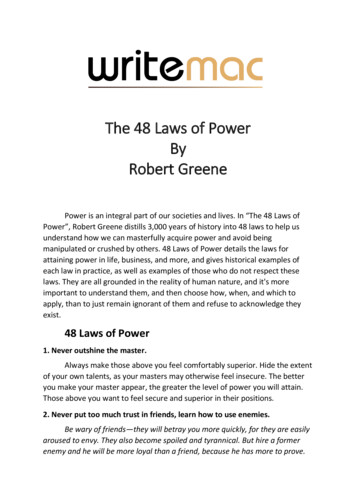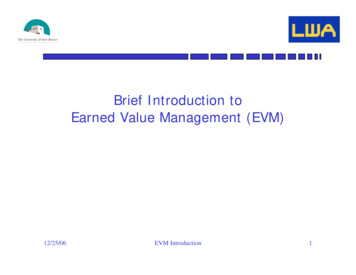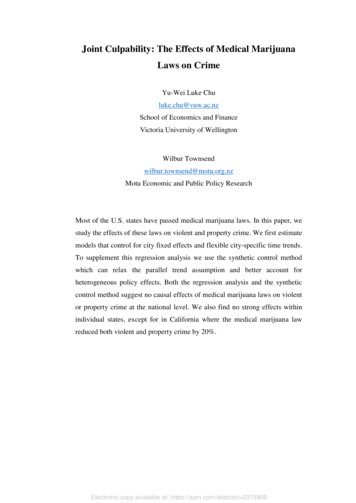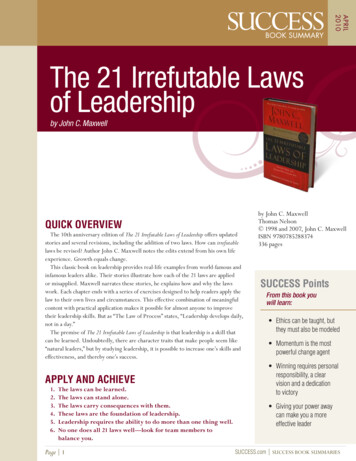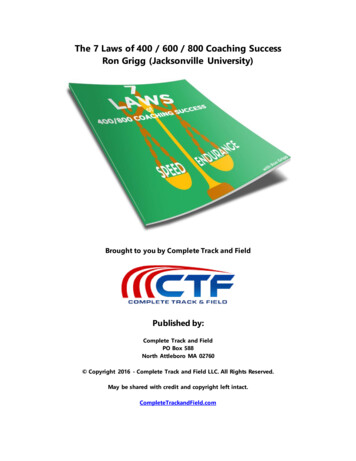
Transcription
The 7 Laws of 400 / 600 / 800 Coaching SuccessRon Grigg (Jacksonville University)Brought to you by Complete Track and FieldPublished by:Complete Track and FieldPO Box 588North Attleboro MA 02760 Copyright 2016 - Complete Track and Field LLC. All Rights Reserved.May be shared with credit and copyright left intact.CompleteTrackandField.com
The 7 Laws of 400/600/800 Meter Coaching SuccessLatif Thomas with Coach Ron Grigg (Jacksonville University)I’m Latif Thomas, owner of CompleteTrackandField.com. As a high school coach, I knowhow difficult it can be to plan effective training, as well as organize and run efficienttraining sessions for this particular event group.Your 400/600/800 runners are too slow to be true sprinters (55m-400m). And they don'tpossess the 'endurance' to be true middle distance runners (800 -1600).In this exclusive report, we're going to explore specific causes of and solutions to theseproblems in order to help you maximize the potential of your athletes.Today, I'm talking to Jacksonville University Head Coach Ron Grigg about the secretsbehind coaching primary event 400/600/800 runners to their best performances.If you’re not familiar with Ron Grigg, take a minute read about some of his coachinghighlights before we get started:Ron Grigg continues to raise the level of the Dolphins’ success as he enters his15th season at the helm in 2016. Grigg became the director of track and field andcross country at JU in 2002 after serving as the associate head coach underformer head coach Becky Motley for a year. Grigg originally came to JU in 1998before leaving to serve as an assistant coach at Kansas State from 1999 to 2001.Grigg has made the Dolphins track program a beacon in the Atlantic SunConference by winning the A-Sun Indoor and Outdoor Championships in each ofthe last 10 seasons – earning “Coach of the Year” in all 20 of those titles, as wellas, earning the United States Track and Field and Cross Country CoachesAssociation South Region Women’s “Coach of the Year” in 2008. Since takingover as head coach, Grigg has directly coached more than 120 conferencechampions in track and more than 250 all-conference performances. Theprogram has also produced greater than 300 Atlantic Sun All-Academicperformers during that time.In 2015, the Dolphins would sweep the indoor and outdoor titles for the 10thstraight year – extending their conference record. The Dolphins have won everyindoor title since the conference added the sport in 2006, while JU’s outdoor teamholds the record for the most consecutive titles in A-Sun history.
At the 2015 NCAA Outdoor Championships, the 4x100 meter squad of ShaniqueWalker, Courtney Walker, Shadaey Campbell, and Ja'Mesha Richard ran a 44.70,placing 13th overall. Walker also competed in the 100 meter hurdles, placingseventh in a time of 12.96 seconds. The Dolphins earned five second team AllAmerica honors.In 2013 Bienna Freeman became the fifth athlete in JU history to earn All-Americahonors after her performance in the 800m at the NCAA OutdoorChampionships. During the season she shattered the school record in the eventby three seconds and nearly matched her record setting time in the semifinals ofthe NCAA’s where she finished with a time of 2:04.71 which was the 10th overalltime for the event.In addition to Freeman, Joane Pierre and sophomore Shanique Walker alsoadvanced to the NCAA Outdoor Championships giving the Dolphins a programbest three representatives. Walker enjoyed a breakout season for the JUculminating with her record setting performance at the A-Sun OutdoorChampionships in which she set the meet record for the 100m hurdles en route toearning 32.5 team points and Most Valuable Performer Honors.Charlene Charles added to her storied JU resume by becoming the first athlete inA-Sun history to win the long jump three times at the Indoor Championships. Shealso was just one of 16 people in the country to qualify for the NCAA IndoorChampionships in the heptathlon before she had to withdraw due to sustaining aserious injury. After missing the entire outdoor season due to the setback,Charles returned for the conference meet where she gutted it out in theheptathlon to win and end her career on a high note.The 2012 cross country season saw history made when Pierre became the firstDolphin in program history to win the individual conference title. She won with atime of 17:17.5 to win and secure first team all-conference honors for the thirdtime in her career. Pierre went on to finish seventh at the NCAA South Regionaland advanced to the NCAA Cross Country Championships and finished hercareer as the program record holder in the 5K (17:17.5) and 6K (20:22.1).In 2009-10, the Dolphins became the first A-Sun school to win the Triple Crownafter securing the cross country, indoor and outdoor track championships.The JU women’s cross country built on its second place finish in 2008 byclaiming six of the top 14 runners in the conference meet to win its first A-SunChampionship in 2009. They also produced a program-best ninth place finish atthe NCAA South Regionals and were ranked as high as eighth in the USTFCCCASouth Region Polls.The Dolphins ended the year by setting points records at the indoor (212) andoutdoor (247) meets to secure their fifth straight conference championships. Due
to the success, both JU relay teams and runners in the 400 and 800-metersearned spots to the NCAA East Preliminary Round. Charlene Charles was one oftwo freshmen to earn a position to the heptathlon at the NCAA Championships.From 2006-09, Grigg worked with Natasha Harvey, who finished her career as oneof the best athletes in school history. Harvey earned a school-record five AllAmerica honors in the long jump, secured seven berths in the NCAAChampionships, produced 18 NCAA regional qualifying marks, won 22 individualconference titles and recorded 35 all-conference honors. She also won “MostOutstanding Performer” meet honors at the A-Sun Championships nine times andcompeted with Team USA twice (2006, 2008).Harvey got it done in the classroom as well, earning JU female “Student of theYear” honors and becoming the first female athlete in school history to be namedA-Sun “Student-Athlete of the Year” for the 2008-09 school year.Grigg also recruited and coached Monique Tubbs, the school's first nationalchampion (60-meter dash, 7.29) and a four-time All-America honoree; and AndreaPressley, who finished fourth in the heptathlon at the 2004 NCAA OutdoorChampionships.Besides the five All-America honorees and the 17 NCAA Division I Championshipqualifiers, school records have been set in 20 of 23 outdoor events and 19 out of21 indoor track events during Grigg's tenure as assistant and head coach.Grigg's teams have also shown success in the classroom, receiving theUSTFCCCA All-Academic Team award for 14 consecutive years (2002-15). Sincehis return in 2001, the Dolphins have had more than 200 academic all-conferenceselections among the cross country and track teams.Also, the cross country, indoor and outdoor track teams have received NCAAPublic Recognition for having APR in the top 10% nationally.-----Now that you know more about the full range of Coach Grigg’s experience and coachingsuccess, let’s dive into "The 7 Laws of 400/600/800 Coaching Success".This isn’t a thesis or an attempt to fill up space with fluff and nonsense. The goal is to giveyou straight forward, practical information you can use to positively improve yourapproach to programming for this fascinating event group and group of athletes.The format is simple: I’ll ask Coach Grigg the question/s and he’ll provide the answer/s. So,let’s get started.
I. The Law of Talent IdentificationLatif Thomas: This event group is commonly referred to as 'tweeners': athletes that don'thave the absolute speed to be successful sprinters, but don't have the "endurance" to bemiddle distance or distance runners. But, you've said that you don't consider the athletes tobe tweeners, but, instead, that the event group itself, as well as the coaches are the tweeners.That coaches, generally, are more comfortable coaching sprinters OR are more comfortablecoaching middle distance and distance runners.That said, how do we assess, address and analyze the biomotor/physical capacities of ourathletes in order to determine whether and where athletes with the particular set ofcapabilities best suited to the 400/600 & 800m events?Ron Grigg: Athletes will show us their gifts by how they are able to handle certain kinds oftraining. It is important to have variety in training so athletes can show us theirgifts. Using a variety of training protocols we should be able to see who are the mostcoordinated athletes, who possess the top speeds, and who excels in those tough “longerfaster rep” sessions. It is easier to compare the athletes who are currently in our traininggroups to one another just through observation.
What is slightly more difficult is determining in which event group they will ultimately besuccessful. That requires a little knowledge on the specific demands of each event.We also need to be able to identify what “good” is in the bigger picture. Just becausesomeone is the fastest kid on your team, does not always mean their best gifts are as ashort sprinter. It may simply mean that we don’t have a population of short spr inters withwhich to work. The fastest person on our team, might be the best 800 meter runner in thestate.So we must provide opportunities in training to assess all of those qualities.II. The Law of Age & GenderLatif Thomas: Once you’ve identified talent, how does age, (training, biological,chronological), as well as gender, affect your approach to developing this event group range?Ron Grigg: The duration of the event will dictate the aerobic/anaerobic energycontributions. So a senior boy and a freshman girl may have different energy needs whileracing the same event.400/600/800 meter success at higher levels requires some physical matu rity. Youngerathletes are better served emphasizing general training on both ends of the speed and
endurance spectrum.When in environments with lots of racing opportunities, it may be appropriate to let theraces serve as the primary means for specific “training.” For example, what do you do whenyou have, say, two dual meets during the week?Having those two meets eliminates the need for any additional specific training. When indoubt, stay general in your training and let the races serve as the specific. The good news isthere is nothing wrong with “racing the athlete into shape” if it can be part of anappropriately designed training plan.Once a coach has an understanding of what qualities to train and how to train them inisolation, then they can get creative in combining some of these qualities in uniqueways. The good news is designing training for the 400/600/800 meter athlete isn’t easy,but nothing worthwhile ever is.III. The Law of EnduranceLatif Thomas: Coaches who come from a ‘distance’ background tend to steer their trainingtoward the ‘high volume, low intensity’ end of the spectrum. Coaches coming from a ‘sprints’background tend to employ a ‘quality over quantity’ approach to training.Athletes who succeed in this event range naturally possess greater speed qualities thanendurance qualities. But, endurance is still a critical, if not predominant demand from aprogram design standpoint.That said, how do you define ‘endurance’ work for this event group and what role does it playin training, compared to a traditional ‘sprints’ or ‘middle distance’ program?Ron Grigg: Endurance has different meanings to different people. Some people think ofendurance as only aerobic training, but I think that do esn’t tell the whole story.There is even an endurance quality to be trained in a 100m race. Sprint coaches might callit Short Speed Endurance.In reality there is a continuum of paces that range from 100 meter pace to marathon pacethat will all develop some forms of endurance required to be successful at 400/600/800meters.
Latif Thomas: Does running mileage develop the endurance qualities required to succeed atthese race distances? If so, how much? If not, what type of work should be done in its place?Ron Grigg: I don’t think in terms of mileage for this group, but there are aerobic trainingqualities that must be addressed and there is a continuous running component to beingsuccessful at 800 meters for sure.If you think you have found an athlete who has the gifts for competing in the 400/600/800meter distances, we have to find a way to address these issues.A few years ago we had an athlete who was an 800 meter specialist who also ran on ourschool record 4x4.The athlete hated distance running.It was frustrating for me as a coach to send the athlete out on a 30 or 45 minute run only tosee that this athlete was already 100 meters behind the distance runners after only 3minutes of running, even though the pace wasn’t fast.This athlete would even get dropped in warm up jogs. It wasn’t that the athlete didn’t havethe ability to handle endurance training successfully, but the athlete’s belief perpetuatedtheir unpreparedness.The results showed in cross country races. The athlete didn’t like the distance running, anddidn’t like the distance races. Therefore the athlete also didn’t believe they were good atanything beyond 800 meters.There is a saying, “whether you think you can or think you can’t, you are absolutely right.”I had to figure out another way to get the athlete the essential aerobic qualities to improve800 meter times.By implementing shorter and slower repetitions with jogging recoveries at ever increasingvolumes, and by implementing shorter continuous tempo runs (such as 10 and 15 minutes)on the track at faster paces, I was able to monitor the efforts and ensure there was properintensity to the volume.
Over the course of 2 seasons the athlete improved their 800 meter personal best by 5seconds and qualified for the NCAA Championships.But the athlete also improved their 1500 meter time by almost 20 seconds, and gained theability and confidence to drop well over 2 minutes for 5k of cross country, all whilecontinuing to get faster over 400 meters!IV. The Law of Strength & PowerLatif Thomas: We can improve our athletes’ overall fitness, running economy and mechanics.And it will improve their performance. But, at some point, especially in the 4/6/8 event rangewhere speed is a necessity, a ceiling is hit if the athlete does not develop increasing levels ofphysical strength and power in order to propel their body farther, faster and while burningless energy to do so.At the same time, athletes competing primarily in the 400/600/800 distances are not truesprinters, throwers or power lifters. The fundamental question is:How much strength training does this group require compared to, say, the standard sprintsgroup?Ron Grigg: Speed and power are essential for success at 400/600/800 meters. These
qualities can be trained in the weight room, but that is not near as important as it would befor a pure sprinter.When they are ready, I like to see that the 400/600/800 meter athletes can squat and cleanwith appropriate techniques for all of the same reasons that those lifts would be importantto sprint training. I like those lifts for their enhancement of core strength, coordination andrange of motion.However, much of this can be addressed away from the weight room, saving the weightroom for later in the progression of strength and power development if appropriate.Latif Thomas: Then what types of strength & power training activities do you favor with thisgroup?Ron Grigg: Strength and power must always be age appropriate. Body weight circuits canbe done to develop general strength. The throwing of medicine balls can be done for powerdevelopment and simple jumping exercises like jump rope can be used to work on elasticstrength.These can all be done with novice athletes, and they will help develop the requisitequalities, concepts and skills that will one-day lead to the weight room.
V. The Law of SpeedLatif Thomas: Let’s get down to brass tacks here.What is the optimal method for approaching speed development with this event group? Is along to short or short to long approach? Both? Neither?Ron Grigg: Speed is the crucial quality in every running event.Races don’t measure how far you go, they measure how fast you get there.Successful athletes in the 400/600/800 meter events have the traits to be fast. We mustmaximize the strengths of our athletes while also minimizing the weaknesses.While short to long may be how to describe the speed training portion of working with400/600/800 meter athletes, it is not that simple. There are many other things that alsoneed to be addressed simultaneously.With this event group there is both a short to long and long to short approach happeningsimultaneously that ultimately meet at the specific race demands for these events.
VI. The Law of Jedi Mind TricksLatif Thomas: Some athletes consider themselves ‘sprinters’ regardless of their performance.At the high school level in particular, there is an assumption that being a sprinter is ‘easier’than being a distance runner. Kids believe that either the training, expectations and/orworkouts are easier and/or that the training/racing doesn’t hurt nearly as much as thelonger endurance based events.Unfortunately, most kids are not built to be 55-400m sprinters.How do we convince 'slow sprinters' to buy into moving up to this event group when theythink they're sprinters and fear the discomfort of training and competing in this event group?Ron Grigg: Everything we train has a progression, including the mentality of theathletes. Athletes tend to like the things they think they are good at, and shy away fromthings they think they are not good at.Our job as coaches is to design training that will allow the athletes to be successful, andtherefore enjoy (or at least not HATE) the training, while still getting the qualities we knowthey need. Sometimes that includes withholding some information, or even trickery.I liken it to how my mom feeds her dog its medicine. If she puts the pill in front of the dog,it will simply stare at it and never take it. But if she puts it inside a piece of baloney, the dogwill take the medicine without ever knowing it was there.With this event group, we often have to design training that looks like training they enjoy,but by manipulating paces, rest intervals and volumes it can achieve the goals we desire.Once the athletes have had some success completing the training and have received thebenefits of physical benefits of that training, they should be able to progress to morechallenging training with an improved confidence in their abilities to be successful at themore challenging training.This is EXACTLY what I had to do with the 800 meter athlete cited in the previous example.But the same has worked for moving kids who thought they were 100 meter runners up tothe 400, and converting heptathletes who were petrified of the 800 into it being one oftheir stronger events when compared to their competition.
VII. The Law of Practice OrganizationLatif Thomas: At the high school level in particular, as coaches we find ourselves in charge oftoo many athletes and not enough time, staff or resources to optimize their training.I want to get the best results for and out of my athletes, regardless of event group, but I haveto be aware of the fact that the more groups I create, the harder it is for me to manageworkouts.This is especially the case with interval type workouts where recording times and managingrest is critical to the success and efficiency of the workout, as well as the physiological effecton the athletes.When it comes to developing primary event 400/600/800 meter runners, should we treatand train these athletes as an entirely separate group (like 'sprints' or 'distance')?Or do we have them train with the distance group? Or the sprints group?Ron Grigg: At any point in time, either or both the sprint group and distance group shouldbe doing training that is appropriate for the 400/600/800 meter athletes.With a little bit of coordination, and probably only minor modifications your 400/600/800meter athlete should be able to thrive in either session. Conversely, you may choose todesign an appropriate training session for the 400/600/800 meter group and then invitethe distance group or the sprint group to join.So, when you have a plan you’re confident in, the answer is:A) sometimes the sprints group,B) sometimes the distance group andC) sometimes their own group.Latif Thomas: Keeping those things in mind, do I model their workout times off of their fastersprint (200) times or their middle distance (800) times?Ron Grigg: I would use 200 meter times when writing workouts that deal with speedendurance qualities. I would use 800 meter times when prescribing any workouts that dealwith endurance qualities.
Theoretical Equivalencies can help you find the proper paces. And remember, trainingzones are exactly that:Zones.While we may come up with exact numbers, the body will receive the benefits of thetraining as long as it is “within a reasonable ballpark.” Then the goal of the coach and theathlete is to assess the training session and design a progression for what it next.
More From Ron Grigg:400/800 Program BlueprintExclusive Offer: Click the above image or link and pay only 9 instead of theeveryday price of 37.Complete Program Design for HS 400/600/800 RunnersExclusive Offer: Click the above image or link and get 10% off the everydayprice of 97 when you use coupon code: GRIGG468
The 7 Laws of 400/600/800 Meter Coaching Success Latif Thomas with Coach Ron Grigg (Jacksonville University) I’m Latif Thomas, owner of CompleteTrackandField.com. As a high school coach, I know how difficult it can be to plan effective training, as well as organize and run eff





